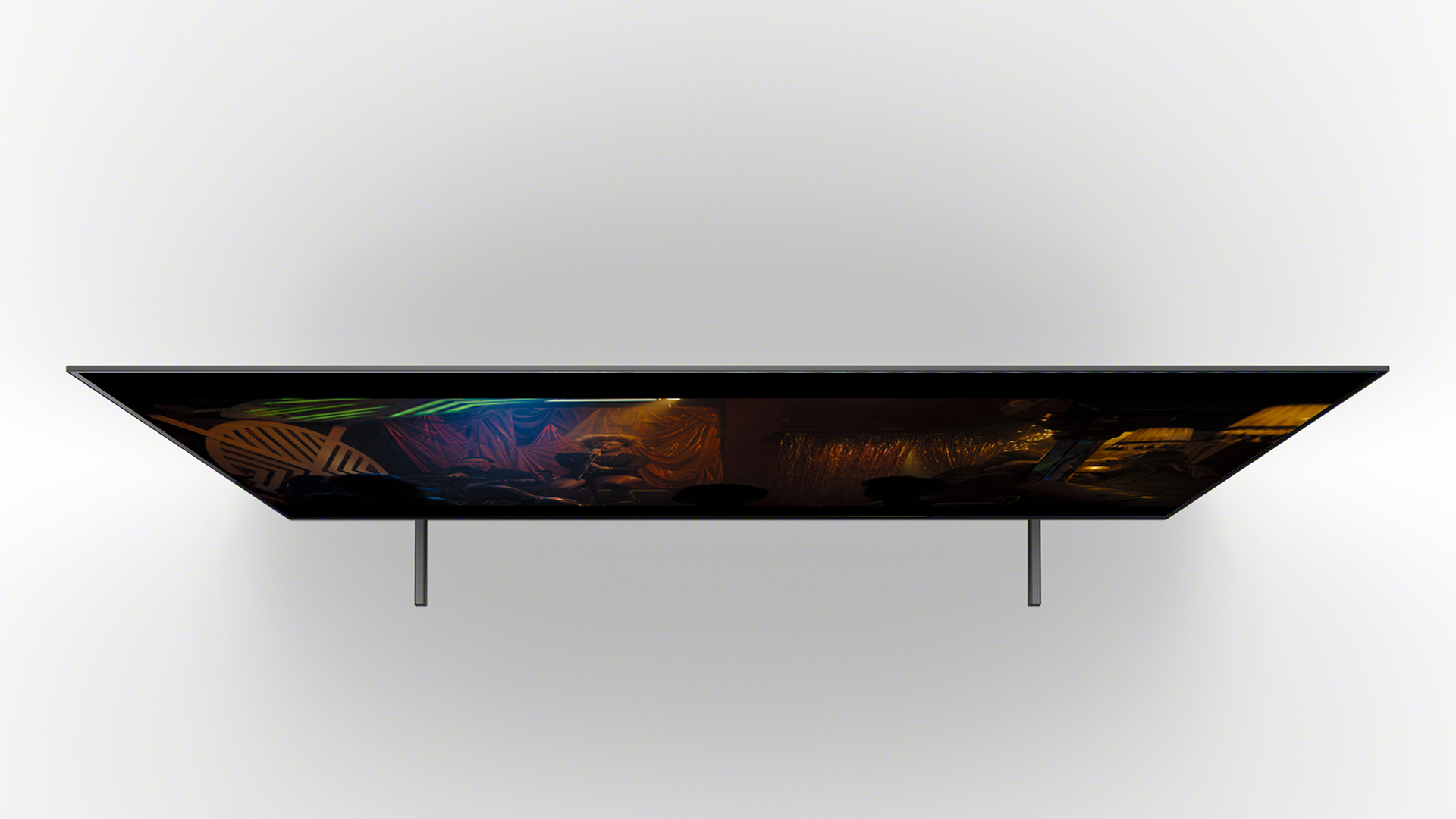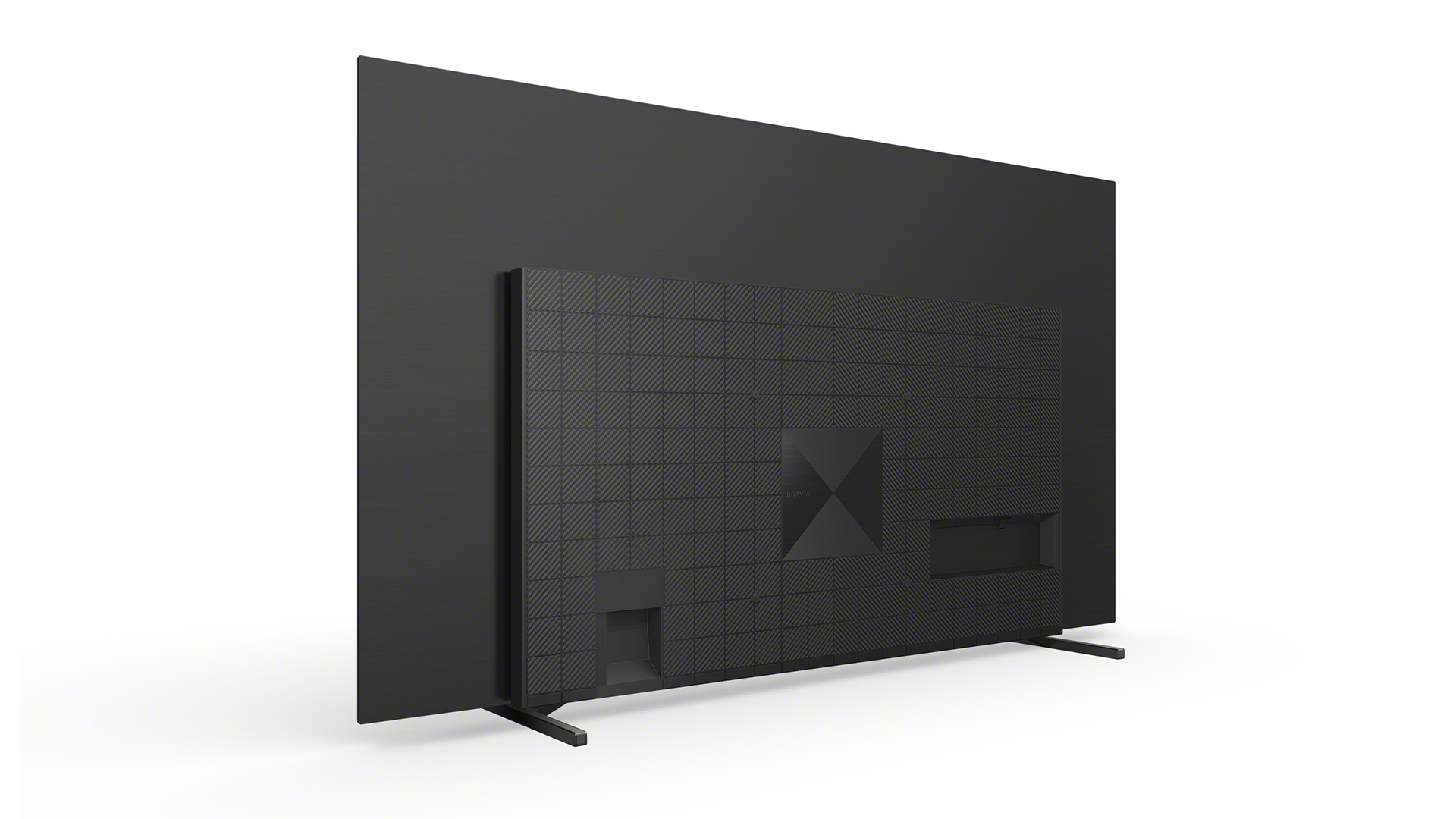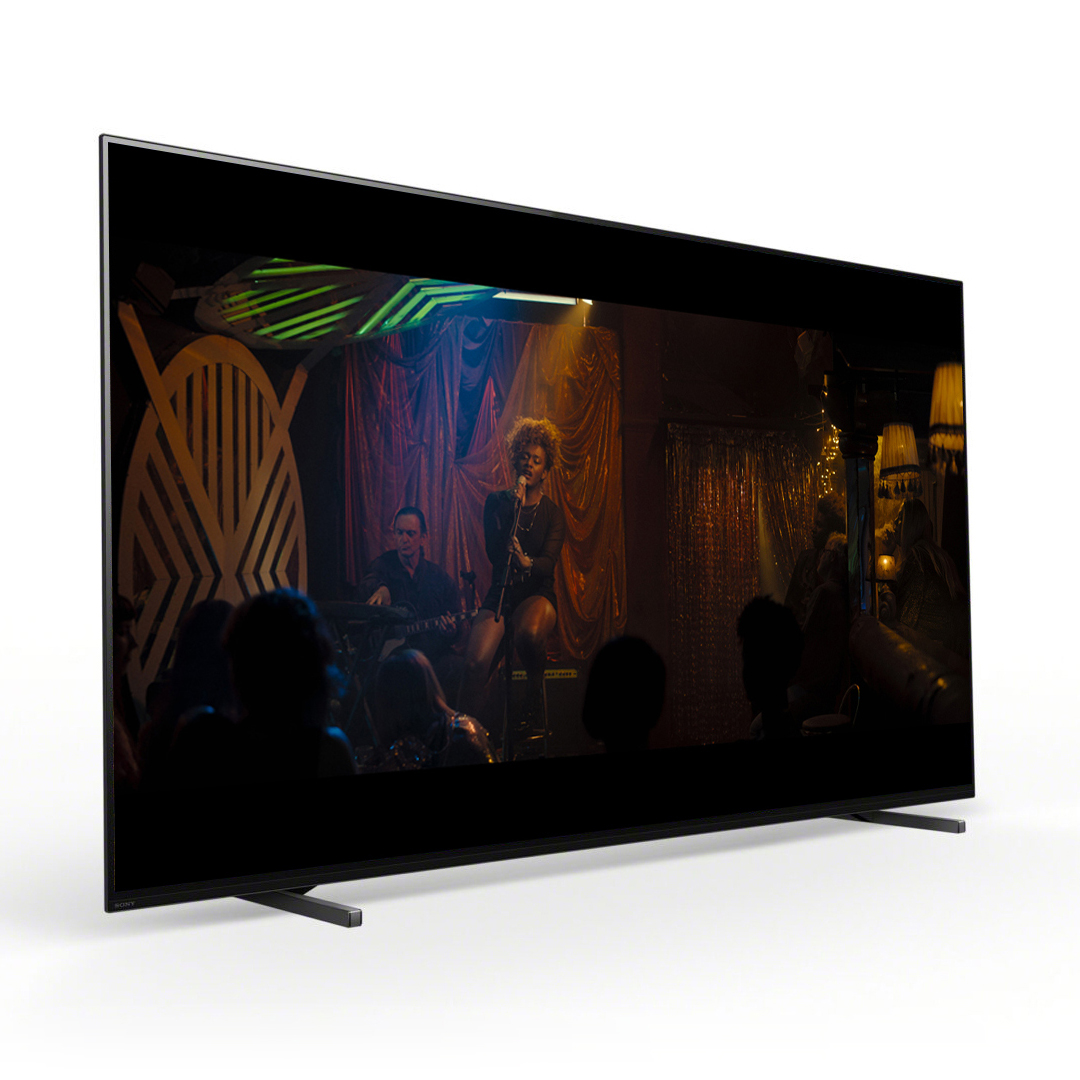What Hi-Fi? Verdict
It’s almost as good as the awesome A90J and a whole lot more affordable, and that makes the Sony A80J / A84J an absolutely brilliant buy
Pros
- +
Super-sharp and detailed
- +
Punchy and vibrant but natural
- +
Superb motion handling
Cons
- -
Incomplete HDMI 2.1 feature set
Why you can trust What Hi-Fi?
We rate products on a performance-per-pound basis. That’s always been the What Hi-Fi? way. We’re not looking simply for the absolutely best product in each category, as that would invariably involve recommending one of the most expensive products in each category; we’re looking for the best bang for your buck. The product that best balances performance, features and price.
That isn’t to say that we’re averse to recommending a premium product when it justifies its high price, and that’s why we were delighted to bestow the full five stars upon Sony’s 2021 flagship OLED when we reviewed it. Simply put, it was the best TV of that year.
It wasn't, though, the best performance-per-pound TV of 2021, because this A80J beat it on that metric. This step-down model in Sony’s new OLED range certainly isn’t quite as good as its flagship sibling (or Sony's new 2022 OLEDs) but, by offering most of what made the A90J great at a much more competitive price, it got itself one of our 2021 Awards – and it's still a great buy now.
Price
The 55-inch Sony XR-55A80J’s price at launch was £1899 / $2300 / AU$2995, but when we first reviewed it in August 2021 it has already dropped to £1699 / $1900 / AU$2795.
In November 2022, you can now pick it up for a significantly lower price of £999 / $1249 / AU$1785. In the UK and Australia, at least, that makes it one of the cheapest 55-inch OLED TVs you can buy, although it should be noted that that's at least partly down to most other 2021 models having been discontinued now, which leaves the A80J competing for your cash against newer, 2022 sets.
For what it's worth, the XR-55A80J's successor, the XR-55A80K, can be bought for £1499 / $1298 / AU$2795.
At the time of writing, it’s a full £1000 ($1000) cheaper than the 55-inch A90J (which isn’t currently available in Australia), yet it features much of the same core technology, including the new Bravia XR processor.
The latest hi-fi, home cinema and tech news, reviews, buying advice and deals, direct to your inbox.
For comparison, the 55-inch LG C1 is currently £1499 ($1500, AU$3076).
In the UK, there’s a variant of the A80J called the A84J. This version has a microphone integrated into its bezel for completely hands-free voice-control (the A80J has only a remote-mounted mic), plus a feature called Rich Colour Enhancer. While Sony says the latter is only enabled when the set’s in its Vivid mode, we’ve tested both models side-by-side and find that there is a very marginal degree of extra richness to the A84J’s colours in other modes, too. The difference is far from pronounced, though, and the sets are otherwise identical. Therefore, this review applies to both the XR-55A80J and XR-55A84J.
Build

Remove an OLED TV from its feet or pedestal and it suddenly becomes exponentially harder to differentiate it from its peers, particularly when viewed square on: they’re all essentially black rectangles surrounded by thin, black bezels. Sony’s 2021 models differ from LG’s by having a company logo stamped on the bottom lip, but it’s so small and subtle as to be almost invisible.
The flagship A90J takes an aesthetically unique stance with its, well, stance, in that its feet extend beyond the left and right edges of the display when fitted in the default position, raising the set off its stand by less than a millimetre. Those same feet can be reversed in order to give the TV a raised, soundbar-friendly posture, but its footprint remains wide, making it potentially awkward to find a home for.
The A80J, by comparison, is less immediately striking but a good bit more accommodating, with its fairly dainty feet positional in either a wide, narrow, or soundbar stance. When they’re in the narrow placement, the set has a footprint that’s a very reasonable 69cm (27.3 inches) wide.
The panel section of an OLED TV is always super-thin, thanks to the lack of a backlight, but a TV is more than its panel, and its processing hardware, speakers and connections all need to be housed somewhere. This ‘somewhere’ is almost always (the obvious exception being LG’s sadly now retired 'Wallpaper' models) a plastic enclosure attached to the rear of the display.
The A80J’s enclosure is more angular than most, and it’s thicker than that of the A90J, making for an overall depth measurement of 5.3cm (2.1 inches) compared to the A90J’s 4.1cm (1.6 inches). That said, it covers less of the set’s rear, which means more of what you see from the sides is exceptionally thin. It also means that the A80J arguably looks more like a floating panel when wall mounted than does its more premium A90J sibling.
Features
Other than the traditional speaker terminals (which the A90J has and the A80J does not), the A80J has identical connections to the A90J, both in terms of positioning and specification. That means you get aerial, satellite (Freesat in the UK), ethernet and optical ports, plus three USBs and four HDMIs.
Of those HDMIs, two are standard HDMI 2.0 spec but two are HDMI 2.1-certified. In terms of bandwidth, those 2.1 sockets are as high-spec as can be, with a data rate of 48gbps. And, thanks to a post-launch software update, the next-gen gaming spec of these HDMI 2.1 sockets is essentially complete, too, with 4K/120Hz, VRR and ALLM all on board. That said, as is still the case with Sony's 2022 TVs, there's quite a lot of faff involved to enable the various gaming features, and while the TV supports Dolby Vision, there's no Dolby Vision game mode, which effectively rules out gaming in Dolby Vision unless you're able to somehow put up with very high input lag. That won't be an issue to PS5 gamers, though, as Dolby Vision gaming is an Xbox-exclusive feature.
Crucially, you don't really get a better gaming spec by opting for one of Sony's newer OLEDs, but LG's C2 and G2 (like the C1 and G1 before them) are even more fully featured, thanks to their four HDMI 2.1 sockets, all of which support 4K/120Hz, VRR, ALLM, Dolby Vision gaming (right up to 4K/120) and HGiG (for more accurate HDR tone-mapping with many games).
Screen type OLED
Resolution 4K
Operating system Google TV
HDR formats HDR10, Dolby Vision, HLG
HDMI x4 (HDMI 2.1 x2)
4K@120Hz Yes
VRR No
ALLM Yes
ARC/eARC eARC
Optical out Yes
It’s also worth pointing out that one of the Sony A80J's HDMI 2.1 inputs is also its eARC/ARC output, so if you need to use eARC/ARC to get sound to your AV receiver or soundbar, you’re going to be left with just one top-spec input. At present, that will only be an issue for the lucky few who have both a PS5 and Xbox Series X (and/or a top-spec gaming PC), but HDMI 2.1 sources could become far more prevalent in the years of service you might reasonably expect to get from a top-end TV.
Of course, if you’re not a hardcore gamer (or even a gamer at all), these HDMI limitations will likely be of no concern to you, and that’s entirely correct. And if you’re a hardcore movie and TV show addict, you’ll be pleased to know that the A80J is, too.
The big news is that it has the same Cognitive Processor XR chip as the A90J, which combines the AI abilities of its X1 predecessor with a system that Sony calls cognitive intelligence. While AI analyses picture and sound signals and uses data based on machine learning, cognitive intelligence aims to add a more human perspective to identify and enhance AV performance and deliver an experience in line with how humans see and hear the world.

This world-first TV picture processing, according to Sony, begins with a scene detection stage to identify and enhance the main focal points and, ultimately, adds a greater sense of depth to the image. The XR processor looks at multiple zones and other elements (colour, contrast, texture, depth, detail, etc) of each frame and performs a cross-analysis to work out the most important areas.
This would sound like so much marketing exaggeration were it not for the hugely impressive performance already put in by the A90J. That said, the A80J lacks the fancy heatsink of its A90J sibling (and 2022's A80K and A95K), which is designed to improve panel efficiency and peak brightness, so we’re not expecting an identical picture performance. It will be interesting to see where the processing similarities and panel differences intersect.
While cold tech specs can be important, the user experience matters too, particularly in this generation of smart TVs. Sony threw its lot in with Google years ago, with previous TV generations running versions of Android TV. The A80J and its contemporaries get the new Google TV platform, though, which is a significant step forward in terms of presentation and usability. That said, the bespoke operating systems offered by Samsung and LG are even nicer to use, and the A80J's Google TV-powered recommendation engine is significantly hampered by the fact that it brings in content from very few of the set's supported apps, with Netflix the most notable absentee.

While not included in recommendations, Netflix content is, of course, available through the A80J, and is presented – along with Amazon Prime Video and Apple TV – in 4K, Dolby Vision and Dolby Atmos, where the content allows. Disney+ is still missing Dolby Atmos support, as it is on many other Google/Android TVs. The YouTube app (now the home of Google Play movies and TV shows) works in 4K and HDR10, Plex and VLC make for easy playback of your stored content, and music streaming comes courtesy of Spotify, Tidal, Amazon Music and Deezer.
Exclusive to Sony’s high-end TVs is the Bravia Core app, which streams blockbuster movies at bitrates higher than any other app and similar to those of a 4K Blu-ray disc. You need an exceptionally fast connection (115Mbps minimum) to hit the highest quality level, but the picture is still impressive over our 80Mbps connection and you'll get more than adequate quality from connections of 10Mbps or more. When you purchase the A80J you receive some tokens that can be used to 'buy' movies on Bravia Core, so it’s free to give the service a try.
UK buyers will be pleased to learn that while they were absent at launch, the UK's core catch-up apps are now all supported by the A80J, and both Now and BT Sport are also on board.
Finally, it’s worth noting that the A80J’s remote, while the same size and shape as that of the A90J, lacks its flagship sibling’s premium materials and thoughtfully implemented backlight. Surprisingly, our main disappointment isn’t the missing backlight, but the unsatisfying sponginess of the buttons. This isn’t a bad remote by any means, thanks to generally decent ergonomics and layout, but we’re not sure why the positive click of the A90J’s zapper had to be sacrificed.
Picture

The big question is, of course, how much of the A90J’s awesome picture performance does the A80J offer? The answer, perhaps surprisingly, is 'most of it'.
Playing Rogue One in Dolby Vision, it’s clear that the A80J can’t hit quite the same peak brightness, presumably because it doesn’t have the A90J’s added heatsink, but it’s not a million miles away. That means it’s a punchy performer in its own right, often producing more impactful peaks – the sun glinting off the planet of Scarif, for example – than the LG C1 (though not the newer, brighter C2). What’s more, the A80J’s bright highlights are packed with detail, colour and shading that most TVs miss, giving the clouds above the planet’s beaches a dramatic level of three-dimensionality and lending Vader’s lightsaber a more menacing vibrancy.
Turning our attention to the other end of the contrast spectrum, while LG’s 2021 OLEDs generally prioritise inky blackness, the Sony A80J skews slightly more towards shadow detail, digging up extra shades in the darkest parts of the picture. It’s still capable of going perfectly black when required of course, and when that’s combined with those extra-bright, full-bodied bright highlights, it makes for a thrillingly dynamic viewing experience.
For general sharpness and detail, the A80J more or less matches the flagship A90J, and that puts it head and shoulders above most rivals in those regards. Every shot is magnificently crisp, but you don’t get any of the sense of exaggeration that you do from some rivals that take a similar approach. That crispness combines with the set’s hugely impressive ability to dig up the finest of details to make images brilliantly lifelike, whether it’s a wide landscape shot or an intense close-up of a character’s face.
The fine balance between excitement and naturalism continues with the colours, which the A80J delivers with a perfect blend of vibrancy and subtlety. This TV delivers all of the vivid thrills you could hope for from Rogue One’s space battles, Mad Max: Fury Road’s flame-throwing car convoy and Blade Runner 2049’s neon-lit city, but you never feel as if any of the bright colours are overcooked, and picture elements that require a gentler touch, such as a character’s skin or leather coat, are reproduced with rare nuance.
When it comes to motion handling, the A80J proves itself to be every bit as accomplished as the A90J, and that makes it better than every non-Sony TV that we’ve tested. The extremely testing moments in Blade Runner 2049, such as K’s car cruising behind some skyscrapers in chapter two and, in a later scene, hurtling towards the ground, are handled with nary a hint of the incredibly complex processing going on behind the scenes. LG’s 2021 and 2022 OLEDs, which are broadly very good handlers of motion, can’t quite keep things as well in check, and the car flutters as the TV struggles to keep track of its movement against the other picture elements.
Of course, you can’t live on a televisual diet of 4K HDR alone, so it’s good news that the A80J also makes the most of lower-resolution, SDR signals. What’s particularly noticeable is how punchy it is with this content – whether you’re watching Scott Pilgrim on 1080p Blu-ray, Big Mouth on Netflix or The Andrew Marr Show from the tuner in standard-def, the image pops in a way that most rivals can’t match, albeit not quite as much as the A90J. With all of these signals, the performance is as clean, controlled and detailed as can reasonably be expected, proving that the A80J is a very accomplished upscaler.
All told, in picture terms, the A80J is essentially the same TV as the A90J but with the punch dialled down a notch or two, and that makes it an extremely impressive performer indeed.
Sound

Sony’s OLEDs have long used something it calls Acoustic Surface Audio for sound. This involves the use of actuators that vibrate the whole screen rather than traditional speaker drivers, although more typical subwoofers are used to fill out the bass.
While the A80J’s system is referred to as Acoustic Surface Audio+, just like the A90J’s, it actually has just half as much power (a total of 30W rather than 60W), and that is made clear in the presentation. Not that the A80J isn’t capable of going loud, because it is, but it doesn’t have quite as much depth or weight to its delivery, either in obviously bassy moments, such as the opening of chapter two of Blade Runner 2049, or simply in deeper voices, such as that of Sapper Morton (Dave Bautista). The A80J doesn’t offer quite as much width in its sonic delivery as the A90J either, although there’s not a lot in it.
And just because the A80J isn’t as bassy or spacious as its much more expensive sibling doesn’t mean it doesn’t sound very good by TV standards. It’s certainly weightier and more controlled at the bottom end than the LG C1 and G1, for example, and significantly punchier and more dynamic, too.
The actuators also do their usual, excellent job of tying the audio to the onscreen action – the sound is literally coming from the screen, and that gives it a directness and immediacy that most TV speaker systems lack. That isn’t to say that the audio is confined to the screen, though. It may not go quite as wide as the A90J, but the A80J is still capable of extending effects a good way beyond the TV’s edges, doing a good job with obvious surround effects such as Joi’s disembodied voice when K returns to his apartment in Blade Runner 2049.
All of that said, even the A90J could and should be improved by a separate sound system, so of course the same is true – only more so – of the A80J. Budget for at least a Sonos Arc, if you can.
Verdict
We knew that the A80J had the potential to be a very good TV, thanks to its shared DNA with the awesome A90J, but we had expected the gap in performance to be fairly big, given the gap in price.
That isn’t the case: the A80J offers most of what makes the A90J great at a far more accessible price. It might not be quite as bright and punchy as its flagship sibling, or as sonically weighty, but in many other ways it’s just as capable. That makes it a remarkably crisp, detailed and dynamic performer for the money, with a superior sound system to its price rivals.
Even deep into 2022, it's a great buy, particularly in the UK and Australia where it's one of the very cheapest 55-inch OLED TVs you can buy. You should of course consider spending a little more on a newer, 2022 TV. The Sony A80K and LG C2 are both better overall, particularly in terms of brightness and, in the case of the LG, even better specified for gaming. But there's no denying that the A80J is still an excellent TV that will reward buyers for years to come.
SCORES
- Picture 5
- Sound 5
- Features 4
MORE:
Read our Sony XR-55A90J review
Read our LG OLED65C1 review
Read our Samsung QE65QN95A review
None of those take your fancy? Check out our Best OLED TVs round-up
Tom Parsons has been writing about TV, AV and hi-fi products (not to mention plenty of other 'gadgets' and even cars) for over 15 years. He began his career as What Hi-Fi?'s Staff Writer and is now the TV and AV Editor. In between, he worked as Reviews Editor and then Deputy Editor at Stuff, and over the years has had his work featured in publications such as T3, The Telegraph and Louder. He's also appeared on BBC News, BBC World Service, BBC Radio 4 and Sky Swipe. In his spare time Tom is a runner and gamer.
- Ketan BharadiaTechnical Editor

